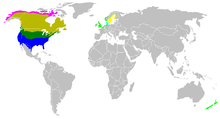
Back Kanadese gans Afrikaans Branta canadensis AN إوزة كندية Arabic اوزه كنديه ARZ Branta canadensis AST Niska ATJ Angsa kanada BAN Казарка канадская Byelorussian Канадска гъска Bulgarian Garreli-Kanada Breton
| Canada goose Temporal range:
| |
|---|---|

| |
| At Seedskadee National Wildlife Refuge | |
| Call of Canada geese on Brownsea Island, Dorset, March 1966 | |
| Scientific classification | |
| Domain: | Eukaryota |
| Kingdom: | Animalia |
| Phylum: | Chordata |
| Class: | Aves |
| Order: | Anseriformes |
| Family: | Anatidae |
| Genus: | Branta |
| Species: | B. canadensis
|
| Binomial name | |
| Branta canadensis | |
| Subspecies | |
| |

| |
| Canada goose distribution: Summer range (native) Year-round range (native) Wintering range (native) Summer range (introduced) Year-round range (introduced) Wintering range (introduced) Summer range (cackling goose)
| |
| Synonyms | |
|
Anas canadensis Linnaeus, 1758 | |

The Canada goose (Branta canadensis) is a large wild goose with a black head and neck, white cheeks, white under its chin, and a brown body. It is native to the arctic and temperate regions of North America, and it is occasionally found during migration across the Atlantic in northern Europe. It has been introduced to France, the United Kingdom, Ireland, Finland, Sweden, Denmark, New Zealand, Japan, Chile, Argentina, and the Falkland Islands.[2] Like most geese, the Canada goose is primarily herbivorous and normally migratory; often found on or close to fresh water, the Canada goose is also common in brackish marshes, estuaries, and lagoons.
Extremely adept at living in human-altered areas, Canada geese have established breeding colonies in urban and cultivated habitats, which provide food and few natural predators. The success of this common park species has led to it often being considered a pest species because of its excrement, its depredation of crops, its noise, its aggressive territorial behavior toward both humans and other animals, and its habit of stalking and begging for food, the latter a result of humans disobeying artificial feeding policies toward wild animals.
- ^ BirdLife International (2018). "Branta canadensis". IUCN Red List of Threatened Species. 2018: e.T22679935A131909406. doi:10.2305/IUCN.UK.2018-2.RLTS.T22679935A131909406.en. Retrieved August 30, 2022.
- ^ Long, John L. (1981). Introduced Birds of the World. Agricultural Protection Board of Western Australia. pp. 21–493.
